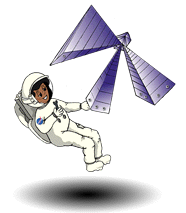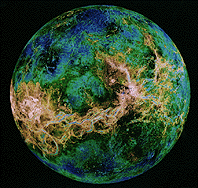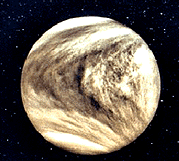|
|
Venus: Earth's Twin |
|
|
Venus: Earth's Twin |
![]()
 |
Guess what?Venus is referred to as the Evening Star because it is the brightest planet that can be viewed from Earth. Its thick cloud cover is an excellent reflector of the Sun's light. |
Venus and Earth are similar in size, composition, and mass. They differ in that Venus does not have oceans or human life, and its temperature during the day reaches 484 degrees Celsius. The daytime temperature is so hot it could melt lead. The dense atmosphere is composed of carbon dioxide and sulfuric acid which acts as a greenhouse and traps the heat. Venus revolves around the Sun in a circular orbit once every 225 Earth days. Venus rotates slowly on its axis in a clockwise direction, which is referred to as a "retrograde" rotation because it is the opposite of the seven other planets. A rotation takes 243 Earth days, so a Venusian day is longer than a Venusian year. As with the other inner planets, the surface of Venus has been shaped by impact craters, tectonic activity, and volcanoes which scientists believe to be ongoing. The volcanic activity is believed to be the source of the sulfur found in the atmosphere. Venus does not have any naturally occurring satellites.
 |
 |
|
RADAR image of the surface of Venus |
A Pioneer Venus picture of Venus |
A QuestionIf you were standing on Venus, why would the Sun appear to rise in the west and set in the east? |
| The Facts |
Did you know? |
The Answer |
![]()
| Show me the Level 1 version of this page. |
The StarChild site is a service of the High Energy Astrophysics Science Archive Research Center (HEASARC), within the Astrophysics Science Division (ASD) at NASA/ GSFC.
StarChild Authors: The StarChild Team
StarChild Graphics & Music: Acknowledgments
StarChild Project Leader: Dr. Laura A.
Whitlock
Curator:
Responsible NASA Official: